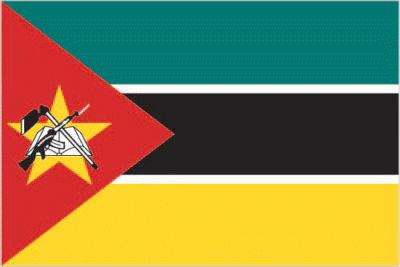| Republic of Mozambique Republica de Mocambique
Origin of Name named for the offshore
island of Mozambique, which was apparently named after
Mussa al-Bik, an influential Arab slave trader who set
himself up as sultan on the island in the 15th century
Location southeastern
coast of Africa
Bordered By Tanzania, Swaziland, South Africa, Zimbabwe, Zambia, Malawi
Area 302,330 sq mi
(783,030 sq km)
Greatest Distance N-S 1,100 mi (1,770 km)
Greatest Distance E-W 680 mi (1,094 km)
Highest Point Monte Binga; 7,992 ft (2,436 m)
Lowest Point sea level
Natural Resources coal, titanium,
natural gas, hydropower, tantalum, graphite
Nationality
Mocambican
Population (June 2015 est) 25,303,113
Largest Cities Maputo, Matola,
Beira, Nampula, Chimoio, Nacala, Quelimane, Tete,
Xai-Xai, Maxixe
Ethnic Groups Makhuwa,
Tsonga, Lomwe, Sena, other tribal groups
Religions Roman Catholic,
Muslim, Zionist Christian, Protestant
Languages Emakhuwa,
Portuguese (official), Xichangana, Cisena, Elomwe,
Echuwabo, other Mozambican languages
Capital Maputo
Form of Government presidential republic
Present Constitution Adopted November
16, 2004
Chief of State President Filipe Jacinto Nyusi
(since January 15, 2015)
Head of Government Prime Minister Carlos
Agostinho Do Rosario (since January 17, 2015)
Cabinet appointed by the President
Legislature unicameral Assembly of the
Republic
Judiciary Supreme Court, Constitutional
Council
Local Administration 10 provinces, 1 city
Currency meticais
(MZM)
Per Capita Income $1,200
Industries aluminum, petroleum
products, chemicals (fertilizer, soap, paints), textiles,
cement, glass, asbestos, tobacco, food, beverages
Agriculture cotton, cashew nuts,
sugarcane, tea, cassava (manioc, tapioca), corn,
coconuts, sisal, citrus and tropical fruits, potatoes,
sunflowers; beef, poultry
Export Commodities aluminum,
prawns, cashews, cotton, sugar, citrus, timber, bulk
electricity
Import Commodities machinery and
equipment, vehicles, fuel, chemicals, metal products,
foodstuffs, textiles
Independence from Portugal
Achieved June 25, 1975
National Holiday Independence Day, June
25
Flag three equal horizontal bands
of green (top), black, and yellow with a red isosceles
triangle based on the hoist side; the black band is edged
in white; centered in the triangle is a yellow
five-pointed star bearing a crossed rifle and hoe in
black superimposed on an open white book; green
represents the riches of the land, white peace, black the
African continent, yellow the country's minerals, and red
the struggle for independence; the rifle symbolizes
defense and vigilance, the hoe refers to the country's
agriculture, the open book stresses the importance of
education, and the star represents Marxism and
internationalism

SEE ALSO
Tanzania
Swaziland
South Africa
Zimbabwe
Questions or comments about this
page?
|
 SKC Films Library
SKC Films Library